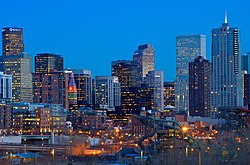| High Plains | |
|---|---|
 A buffalo wallow on the High Plains. [1] | |
 Physiographic regions of the United States. The High Plains region is the center yellow area designated 13d. [2] | |
| Floor elevation | 1,500–6,000 ft (460–1,830 m) [3] |
| Length | 800 mi (1,300 km) |
| Width | 400 mi (640 km) |
| Area | 174,000 sq mi (450,000 km2) [4] |
| Geography | |
| Country | United States |


The High Plains are a subregion of the Great Plains, mainly in the Western United States, but also partly in the Midwest states of Nebraska, Kansas, and South Dakota, generally encompassing the western part of the Great Plains before the region reaches the Rocky Mountains. The High Plains are located in eastern Montana, southeastern Wyoming, southwestern South Dakota, western Nebraska, eastern Colorado, western Kansas, eastern New Mexico, the Oklahoma Panhandle, and the Texas Panhandle. [5] The southern region of the Western High Plains ecology region contains the geological formation known as Llano Estacado which can be seen from a short distance or on satellite maps. [6] From east to west, the High Plains rise in elevation from around 1,500 to 6,000 ft (460 to 1,830 m). [3]






